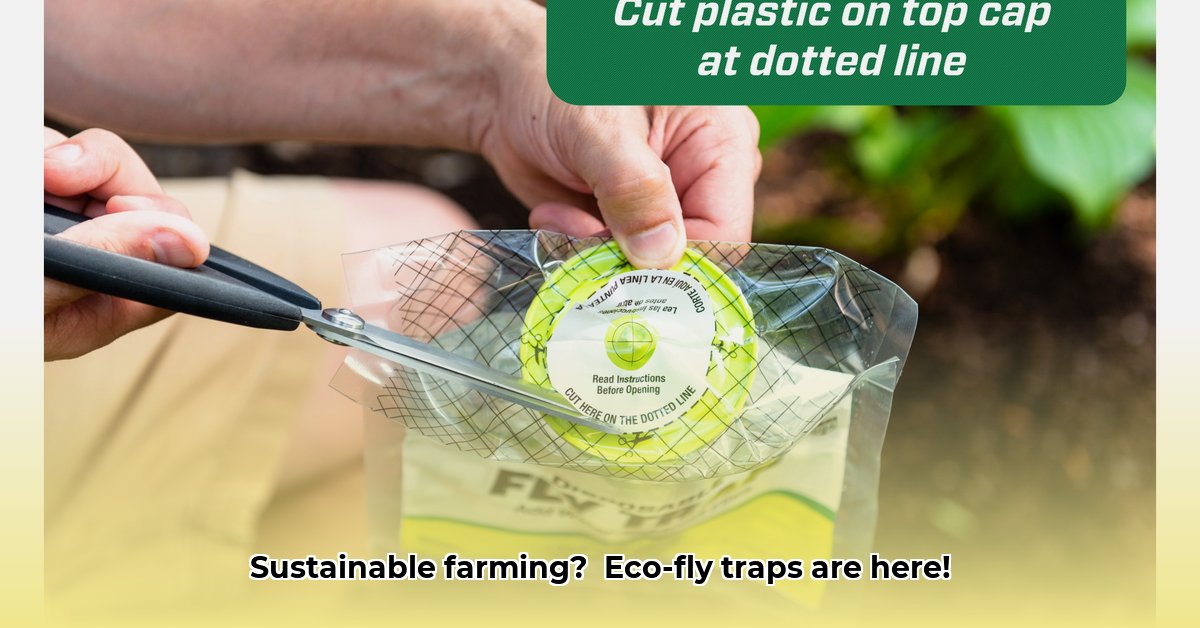
Sustainable Pest Control: A Growing Need
Chemical pesticides, while effective in controlling pests, carry significant environmental drawbacks. Their impact on beneficial insects, soil, and water necessitates a shift towards more sustainable alternatives. This is where eco-friendly fly traps, readily available at Tractor Supply, present a compelling solution. These traps offer a potentially more environmentally sound approach to pest management, minimizing harm to the ecosystem while safeguarding crop yields. But how effective are they, and how do they integrate into a broader sustainable farming strategy? For more information on farm equipment, check out Tractor Supply's website.
How Fly Traps Work: A Natural Approach
Tractor Supply offers various fly traps, primarily employing attractants mimicking the smell of decomposing organic matter to lure flies. Once lured, flies are either trapped in a cage-like structure or become stuck to a sticky surface. The simple, low-maintenance design makes them a practical choice for farmers. However, their efficacy is context-dependent and should be thoroughly evaluated for your specific farm.
The Advantages of Reusable Fly Traps
Reusable fly traps offer several key advantages over chemical pesticides and disposable traps:
Reduced Environmental Impact: By significantly reducing or eliminating pesticide use, these traps lessen harmful effects on beneficial insects and the environment, promoting biodiversity and ecosystem health.
Long-term Cost Savings: The initial investment in reusable traps is offset by the elimination of recurring pesticide and disposable trap purchases, leading to long-term cost savings.
Ease of Use and Maintenance: Many traps are designed for simplicity, requiring minimal time and effort for setup and maintenance.
Improved Crop Protection: By preventing fly infestations, these traps ultimately safeguard crop yields and reduce losses.
Potential Limitations and Considerations
While offering numerous benefits, several factors merit consideration:
Variable Effectiveness: Trap effectiveness varies based on the attractant, fly species, and infestation level. They may not be sufficient for large-scale infestations.
Scalability Challenges: Implementing traps across vast farms can be expensive and labor-intensive, potentially requiring integration with additional pest control methods.
Non-Target Catch: There is a possibility of unintentionally trapping beneficial insects. Careful trap selection and monitoring are crucial to minimize this risk.
Choosing the Right Fly Trap: A Tailored Approach
Selecting the most suitable fly trap depends on several key factors:
Target Species: Different flies respond to different attractants. Identifying the specific fly species is critical for optimal efficacy.
Farm Size and Infestation Level: The number of traps required will vary based on your farm's size and the severity of the infestation. Larger operations may require a combination of traps and other methods.
Budget: Consider the initial investment and long-term cost savings when selecting a trap type.
Integrating Fly Traps into an Integrated Pest Management (IPM) Strategy
For the most effective pest management, integrating fly traps into a comprehensive IPM strategy is crucial. An IPM approach utilizes multiple techniques to control pests sustainably and minimize environmental harm. This often includes:
Crop Rotation: Rotating crops disrupts pest life cycles and reduces their populations.
Natural Predators: Introducing beneficial insects can further control fly populations naturally.
Sanitation: Eliminating decaying organic matter reduces fly breeding grounds and prevents infestations.
Dr. Eleanor Vance, entomologist at Cornell University, emphasizes, "A well-rounded IPM strategy combines multiple approaches, maximizing effectiveness while minimizing environmental impact. Fly traps are a valuable component of this system."
Comparative Analysis of Reusable Fly Trap Efficacy
To effectively compare reusable fly traps against alternative sustainable pest control methods, conduct a thorough evaluation across various criteria. This should include:
Define your specific needs: Identify the target fly species, budget limitations, and preferred maintenance level.
Research alternative methods: Explore options such as diatomaceous earth (DE), natural predators, or improved sanitation.
Gather data on efficacy: Research the effectiveness of various methods against your target species from reliable sources including peer-reviewed studies and verified farmer testimonials.
Analyze cost considerations: Calculate initial and long-term costs for each method, comparing total cost of ownership.
Evaluate environmental impact: Assess the environmental footprint of each method.
Compare and contrast results: Create a summary table comparing effectiveness, cost, and environmental impact to determine the most suitable option.
Example Comparative Table: (Note: Actual data should replace placeholders below and reflect specific trap and control method choices.)
| Method | Effectiveness (against Fruit Flies) | Cost (estimated) | Maintenance | Environmental Impact |
|---|---|---|---|---|
| Reusable Sticky Trap | Moderate (60%) | Low | Weekly cleaning | Low |
| Reusable Electric Trap | High (85%) | Medium-High | Monthly cleaning | Moderate (energy use) |
| Diatomaceous Earth (DE) | Moderate (70%) | Low | One-time application | Very Low |
| Improved Sanitation | High (preventative, 90%) | Variable | Ongoing | Very Low |
This systematic approach allows for a data-driven decision, selecting the most effective and sustainable pest control strategy for your specific needs.
The Future of Sustainable Pest Control
Research continuously advances sustainable pest control methods. Ongoing innovations include improved attractants, eco-friendly trap materials, and more efficient trap designs. These advancements promise even more effective and environmentally friendly solutions in the future, reducing reliance on harmful chemical pesticides.